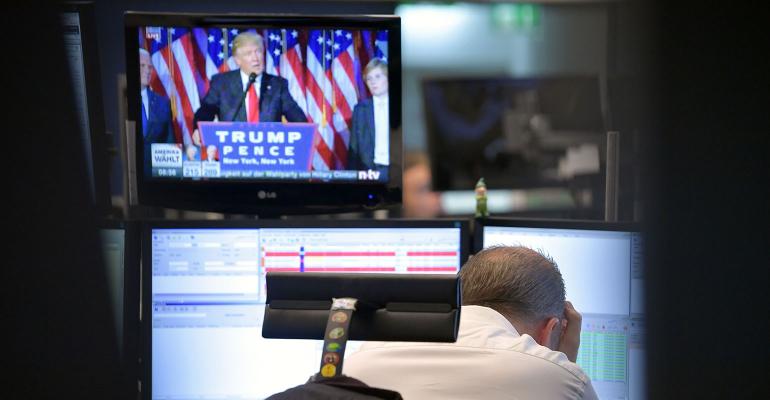By Satyajit Das
(Bloomberg View) --The consensus view is that the Trump rally is over. The interesting question is why.
Stock prices are no longer rising. U.S. bank shares (up around 30 percent from late last year) have plateaued. The VIX Index, an indicator of volatility, has risen sharply, though it remains below historical averages. U.S. Treasury bond yields have fallen significantly, down around 0.3 percent from their highs in December 2016. Commodity prices have slumped.
These developments have unfolded despite solid and largely unchanged economic conditions. So analysts have seized upon alternative explanations for the gloom. One theory is that hopes for the new U.S. administration have been dashed. President Donald Trump promised that with the support of a Republican-controlled legislature, he would cut taxes, initiate large-scale infrastructure spending, reform the tax system, fix healthcare and reduce the regulatory burden on business. Trade issues would be addressed. The U.S. would extract itself from foreign entanglements.
Instead Trump appears to have been captured by existing Washington cabals and forced to accommodate to political realities. This is evident in his geopolitical shifts. The president’s economic priorities -- most importantly tax reform, infrastructure spending and deregulation -- have gone unfulfilled.
There are two things wrong with this theory, however. For one thing, it overlooks the very real limits on the power of any elected politician, even POTUS. For another, it ignores crucial environmental factors -- including interest rates, debt levels, asset values and international conditions -- that were always likely to constrain the rally.
Comparisons have been made to the burst of optimism -- “morning in America” -- that spread through President Ronald Reagan’s first term in the early 1980s. Yet back then, interest rates had plenty of room to fall. The federal funds rate was 18 percent, the 10-year Treasury rate around 15 percent and mortgage rates over 16 percent. Today, these rates are 0.75 percent, 2.3 percent and around 4 percent, respectively. The annual inflation rate was around 8-10 percent then versus 2 percent today. There’s little chance for falling inflation and interest rates to drive growth. In fact, official interest rates are rising.
In the early 1980s, total U.S. debt was 90 percent of GDP, compared to 360 percent currently. U.S. government debt-to-GDP was around 30 percent as against roughly 100 percent at present. Household debt was around 60 percent versus 130 percent today. The personal savings rate was 10 percent rather than 5 percent. The scope for debt-funded expansion or increases in spending from reduced savings is limited. The burden of servicing high debt levels constrains growth. It also restricts Trump’s ability to implement ambitious government spending programs.
In the early 1980s, stock values were lower. The average price-to-earnings ratio was around 7 times, not the current 17-18 times. The median price-to-sales ratio for S&P 500 stocks was around 0.5 times. It is currently over 2 times. Low valuations underpinned the 1980s stock rally. Given current high valuations, a similar rise in equity markets was always tenuous.
Demographic differences are also important. In 1980, the average baby boomer was in her mid-twenties rather than approaching retirement. The problems of an aging population affect current growth prospects and public finances.
In the 1980s, technological developments in personal computers, fiber-optic communications and the internet lay ahead rather than in the past. While technical innovations continue, there is little evidence that they will be as transformational as those in earlier decades.
The international environment improved throughout the Reagan years and beyond. A decline in global tensions, with the collapse of the Soviet Union and the reintegration of India, China and several formerly communist nations into the global economy, provided important impetus for growth. These economies brought around 1.5 billion new workers and consumers into the international trading system. Reduced defense spending freed capital and manpower for other productive uses.
These events aren’t repeatable. Today, global tensions and defense spending are rising, reversing the so-called peace dividend. Global trade restrictions declined in the 1980s. Today they’re increasing.
The success or otherwise of any political leaders has always been a matter of luck and external factors beyond their control. The rally that began in late 2016 may have been driven by factors entirely unrelated to Trump’s election. The primary driver was the rapid credit expansion in China, which drove investment demand and higher imports. An allied factor was the rise in commodity prices and volumes resulting from Chinese demand, OPEC production cuts and interruptions in production. As these factors have reversed, so has the Trump trade.
Ultimately, theories about the Trump rally merely attest to financial markets’ love of convenient and plausible narratives that find cause-and-effect relationships where none exist. The truth, all too often, is far more mundane.
This column does not necessarily reflect the opinion of the editorial board or Bloomberg LP and its owners.
Satyajit Das is a former banker whose latest book is "A Banquet of Consequences." He is also the author of "Extreme Money" and "Traders, Guns & Money."
To contact the author of this story: Satyajit Das at [email protected] contact the editor responsible for this story: Nisid Hajari at [email protected]
For more columns from Bloomberg View, visit bloomberg.com/view

